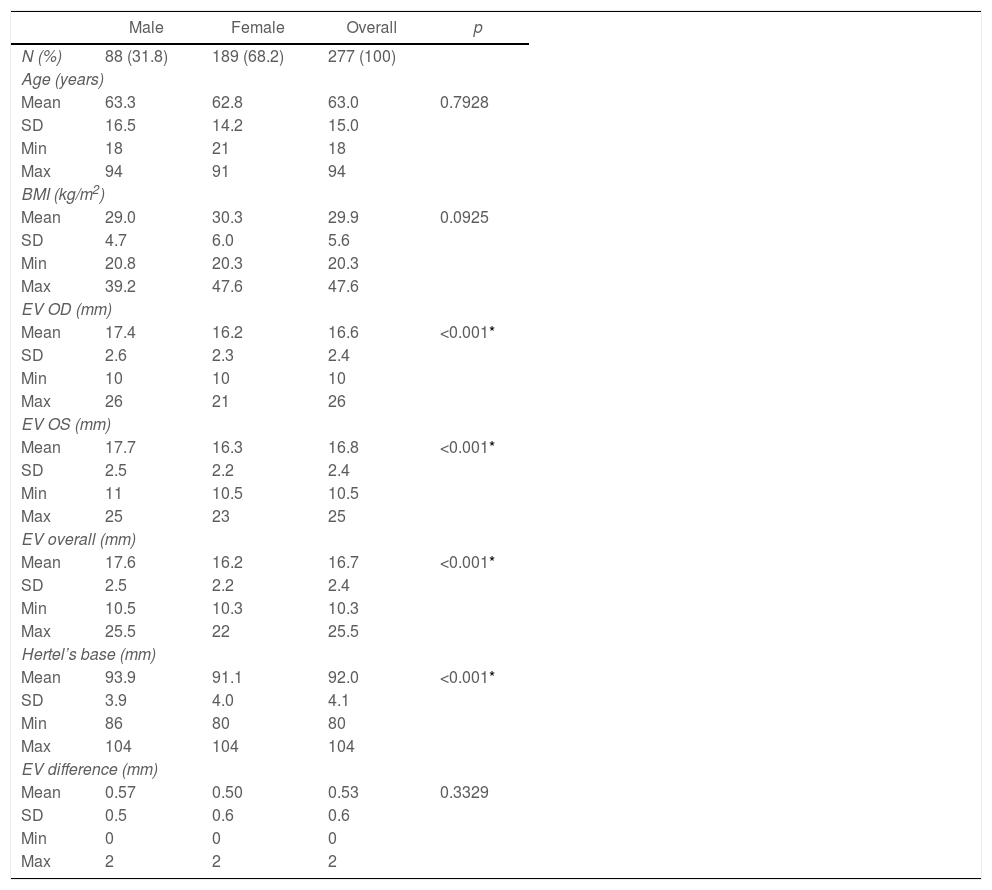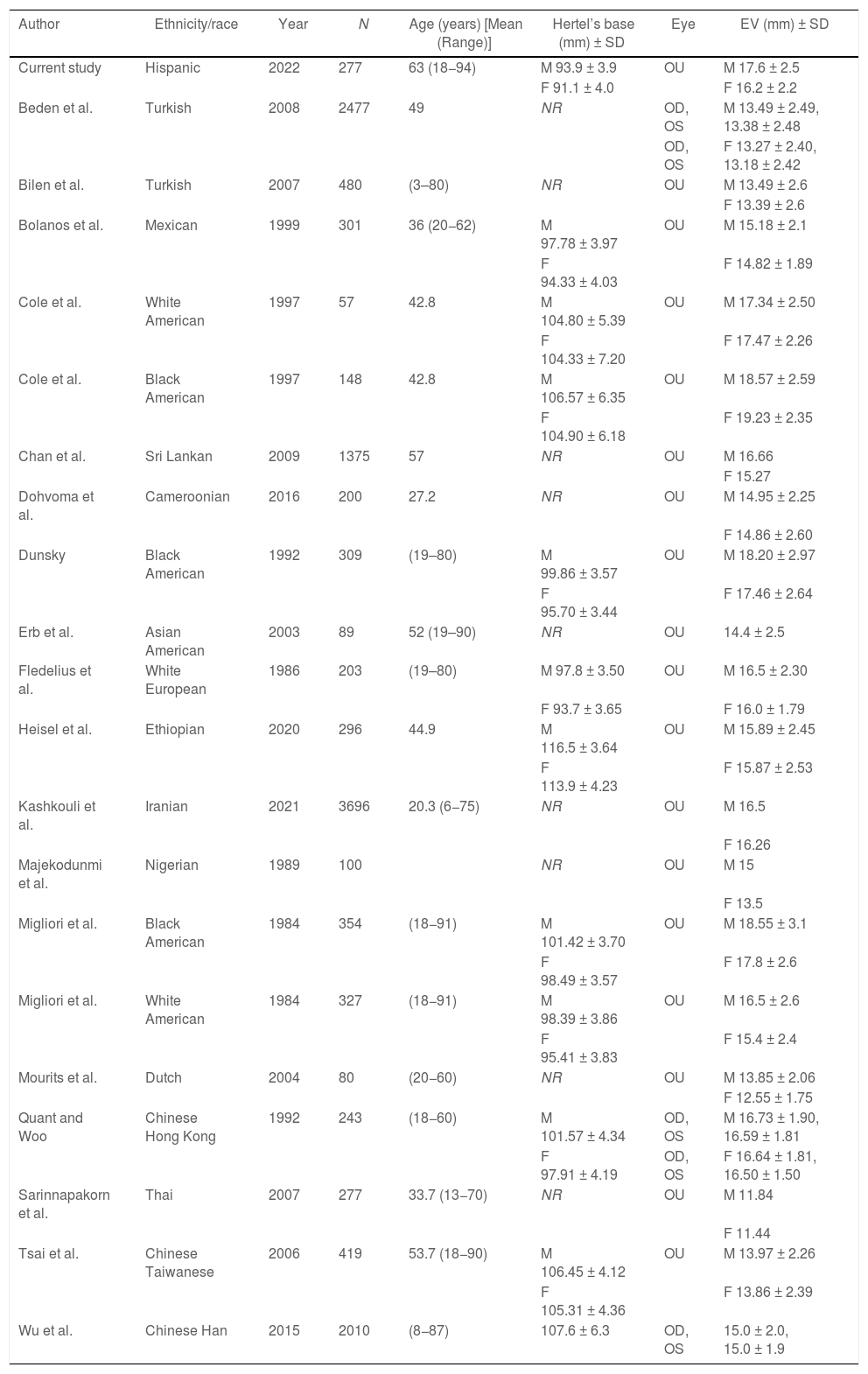Normative exophthalmometry values have been established in Caucasians, Asians, and Black individuals. While prior studies have examined periocular measurements in different racial and ethnic groups, this study is the first to establish a set of normative exophthalmometry values in a Hispanic population in New York City.
MethodsThis prospective, cross-sectional cohort study was IRB approved and HIPAA compliant. Adult patients self-identifying as Hispanic were included. The degree of ocular prominence (exophthalmometry value, EV) and the inter-orbital distance (Hertel’s base, IOD) was obtained by Hertel exophthalmometry. Differences in EV between sexes were evaluated using two sample t-tests. Multivariable linear regression was utilized to determine the effect of age, sex, and body mass index (BMI) on EV.
ResultsOf the 277 Hispanic individuals included, 189 (68.2%) were female and the mean age was 63.0 years (SD = 15.0). The mean Hertel’s base and mean EV for all participants was 92.0 mm (SD = 4.1) and 16.7 mm (SD = 2.4), respectively. Average exophthalmometry values for men were significantly higher than women’s (17.6 mm and 16.2 mm, respectively, p ≤ 0.001). Higher EVs were positively associated with male gender (ß = −1.60, p < 0.0001) and BMI (ß = 0.084, p = 0.001), but not age.
ConclusionsThe mean EV in Hispanic individuals is 16.7 mm, higher than that reported for most Caucasians and Asians, but less than that of Black individuals. Higher EV is significantly associated with male sex and increased BMI. This study is the first to create a set of normative exophthalmometry values in a Hispanic population, which may serve as a valuable tool for clinicians to reference when diagnosing and monitoring orbital disease.
Se han establecido valores normativos de exoftalmometría en individuos caucásicos, asiáticos y negros. Aunque estudios anteriores han examinado las medidas perioculares en diferentes grupos raciales y étnicos, este estudio es el primero en establecer valores normativos de exoftalmometría en una población hispana de la ciudad de Nueva York.
MétodosEste estudio de corte transversal fue aprobado por el IRB y cumple con HIPAA. Se incluyeron pacientes adultos hispanos. El grado de prominencia ocular (valor de exoftalmometría, VE) y la distancia interorbitaria (base de Hertel, DIO) se obtuvo mediante el uso del exoftalmómetro de Hertel. Las diferencias en VE entre sexos se evaluaron utilizando la prueba t para dos muestras. Se utilizó modelo de regresión lineal múltiple para determinar el efecto de la edad, el sexo y el índice de masa corporal (IMC) en el VE.
ResultadosDe los 277 individuos hispanos incluidos, 189 (68,2%) fueron mujeres y la edad media fue de 63,0 años (DE = 15,0). La media de la base de Hertel y del VE para todos los participantes fue de 92,0 mm (DE = 4,1) y 16,7 mm (DE = 2,4), respectivamente. Los valores medios de exoftalmometría de los hombres fueron significativamente más altos que los de las mujeres (17,6 mm y 16,2 mm, respectivamente, p ≤ 0,001). Los VE más altos se asociaron positivamente con el sexo masculino (ß = −1,60, p < 0,0001) y el IMC (ß = 0,084, p = 0,001), pero no con la edad.
ConclusionesEl VE en individuos hispanos es de 16,7 mm, el cual es mayor que el reportado para la mayoría de los caucásicos y asiáticos, pero menor que el de los individuos negros. Un VE más alto se asocia significativamente con el sexo masculino y un mayor IMC. Este estudio es el primero en crear los valores normativos de exoftalmometría en una población hispana y que puede ser utilizado como herramienta de referencia para en el diagnóstico y control de enfermedades orbitarias.









